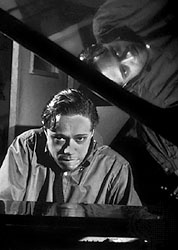Silver, Horace
American musician
born Sept. 2, 1928, Norwalk, Conn., U.S.
 American jazz pianist, composer, and bandleader, exemplary performer of what came to be called the hard bop style of the 1950s and '60s. The style was an extension of bebop, with elements of rhythm and blues, gospel, and Latin-American music added. The style was marked by increased interest in composing original tunes with unusual structures, in place of the bebop practice of loosely basing improvisations on the chord progressions of a few favourite pop tunes such as “I Got Rhythm,” “Indiana,” and “What Is This Thing Called Love?”
American jazz pianist, composer, and bandleader, exemplary performer of what came to be called the hard bop style of the 1950s and '60s. The style was an extension of bebop, with elements of rhythm and blues, gospel, and Latin-American music added. The style was marked by increased interest in composing original tunes with unusual structures, in place of the bebop practice of loosely basing improvisations on the chord progressions of a few favourite pop tunes such as “I Got Rhythm,” “Indiana,” and “What Is This Thing Called Love?”During the mid-1950s Silver was heard on records with Stan Getz (Getz, Stan), Miles Davis (Davis, Miles), and Art Blakey (Blakey, Art), and he cofounded the most typical hard bop group of the 1950s—the Jazz Messengers—with the latter. Silver then formed his own series of excellent quintets. Instead of having ensemble statements only at the beginning and end of a piece, the middle being simply a container for improvised solos, Silver wrote ensemble passages positioned within and between improvised solos, and he further arranged his music by using repeating accompaniment patterns instead of conventional “comping” (sporadic, syncopated bursts of chording that flexibly respond to the directions indicated by the improvising soloist). He also wrote bass lines to fit his left-hand piano figures. The harmonies he wrote for saxophone and trumpet, often fourths and fifths, made the quintet sound much larger than most bebop quintets. Silver's piano solos were exceptionally clear and melodic, and he was not given to the standard practice, typified by his prime influence (Bud Powell (Powell, Bud)), of improvising long, complex lines of eighth notes.
Silver's best-known and longest-lived quintet (1958–64) had trumpeter Blue Mitchell and tenor saxophonist Junior Cook, but over the years Silver also employed many other outstanding musicians, including saxophonists Joe Henderson and Michael Brecker, trumpeters Art Farmer and Randy Brecker, and drummers Roy Brooks and Al Foster. Silver's best-known compositions include “The Preacher,” “Señor Blues,” “Song for My Father,” “Sister Sadie,” “Nica's Dream,” and “Filthy McNasty.” Silver exerted a wide influence, touching many pianists and jazz organists with the blues-derived aspects of his playing.
- Austen, Jane
- Austerlitz, Battle of
- Auster, Paul
- Austin
- Austin, Alfred
- Austin College
- Austin Dobson
- Austin Flint
- Austin, Frederic
- Austin, Herbert Austin, Baron
- Austin, John
- Austin, John Langshaw
- Austin, Louis Winslow
- Austin, Mary
- Austin, Stephen
- Australia
- Australia Day
- Australia, flag of
- Australian Aboriginal languages
- Australian Aborigine
- Renmark
- Renmin Ribao
- Rennell Island
- Rennell, James
- Renner, Karl